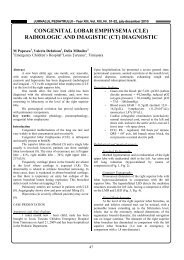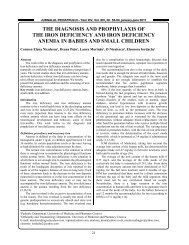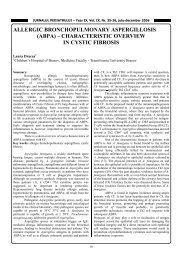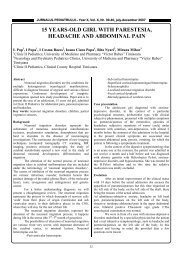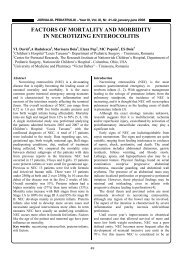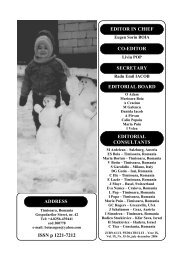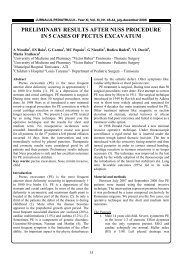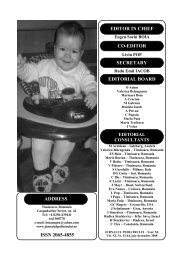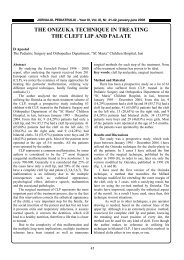the teenagers with suicide and parasuicide attempts and their family
the teenagers with suicide and parasuicide attempts and their family
the teenagers with suicide and parasuicide attempts and their family
Create successful ePaper yourself
Turn your PDF publications into a flip-book with our unique Google optimized e-Paper software.
JURNALUL PEDIATRULUI – Year X, Vol. X, Nr. 37-38, january-june 2007<br />
THE TEENAGERS WITH SUICIDE AND PARASUICIDE<br />
ATTEMPTS AND THEIR FAMILY<br />
Dana Metea Stefanescu 1 , I Popa 1 , Rodica Urtila 1 , Sonia Tanasescu 1 , Otilia Cinca 2 , Luminita<br />
Ionica 2<br />
1 Clinic II Pediatrics – University of Medicine <strong>and</strong> Pharmacy Timisoara.<br />
2 Neuropsychiatry department of <strong>the</strong> Center for Children Diagnose <strong>and</strong> Treatment Nr2 Timisoara.<br />
Summary<br />
The adolescence, considered as "<strong>the</strong> age of <strong>the</strong><br />
second birth" is characterized by <strong>the</strong> spectacular aspect of<br />
<strong>the</strong> transformations that <strong>the</strong> individual is going through, in<br />
all respects, including that of personality development. The<br />
purpose of <strong>the</strong> study is represented by <strong>the</strong> evaluation of <strong>the</strong><br />
familial impact on <strong>the</strong> motivation in <strong>the</strong> teenage suicidal<br />
attempt. The study group was made up of 60 <strong>teenagers</strong>,<br />
hospitalized in <strong>the</strong> Pediatric Clinic II Timisoara, diagnosed<br />
<strong>with</strong> suicidal attempt <strong>and</strong> eventually taken in charge by <strong>the</strong><br />
Neuropsychiatry department of <strong>the</strong> Center for Children<br />
Diagnose <strong>and</strong> Treatment. Conclusions:<strong>the</strong> teenage suicidal<br />
attempt represents a phenomenon <strong>with</strong> an increasing<br />
incidence. The dynamic factors of <strong>the</strong> <strong>family</strong> life are<br />
involved in <strong>the</strong> psychogenesis of <strong>the</strong> maladjusted suicidal<br />
behaviour.<br />
Key words: suicidal attempt, teenage, personality<br />
development.<br />
Introduction<br />
The adolescence, considered as "<strong>the</strong> age of <strong>the</strong><br />
second birth" is characterized by <strong>the</strong> spectacular aspect of<br />
<strong>the</strong> transformations that <strong>the</strong> individual is going through, in<br />
all respects, including that of personality development. The<br />
teenage model of personality is influenced by <strong>the</strong> <strong>family</strong><br />
environment. In <strong>the</strong> context of <strong>the</strong> above-mentioned aspects,<br />
<strong>the</strong> suicidal act can be <strong>the</strong> expression of maladjustment to<br />
<strong>the</strong> <strong>family</strong> environment.<br />
Purpose of <strong>the</strong> paper<br />
The purpose of <strong>the</strong> study is represented by <strong>the</strong><br />
evaluation of <strong>the</strong> familial impact on <strong>the</strong> motivation in <strong>the</strong><br />
teenage suicidal attempt, by taking into consideration two<br />
aspects: <strong>the</strong> familial environment <strong>and</strong> <strong>the</strong> teenager<br />
personality.<br />
Material <strong>and</strong> method<br />
The study group was made up of 60 <strong>teenagers</strong>,<br />
hospitalized in <strong>the</strong> Pediatric Clinic II Timisoara, diagnosed<br />
<strong>with</strong> suicidal attempt <strong>and</strong> eventually taken in charge by <strong>the</strong><br />
Neuropsychiatry department of <strong>the</strong> Center for Children<br />
Diagnose <strong>and</strong> Treatment.<br />
The patients have been analyzed from <strong>the</strong><br />
following points of view:<br />
- identity data<br />
- characteristics of <strong>the</strong> <strong>family</strong> environment<br />
- triggering factors of <strong>the</strong> suicidal act.<br />
THE IDENTITY DATA of <strong>the</strong> study group reveal:<br />
- average age: 15,5 years<br />
- sex: <strong>the</strong> females represent 80%, <strong>the</strong> males represent<br />
20%<br />
- <strong>family</strong> environment: 70% of <strong>the</strong> cases come from<br />
numerous families (<strong>with</strong> more than 4 children)<br />
Sex distribution<br />
20%<br />
boys<br />
girls<br />
80%<br />
20
JURNALUL PEDIATRULUI – Year X, Vol. X, Nr. 37-38, january-june 2007<br />
THE CHARACTERISTICS OF THE FAMILY<br />
ENVIRONMENT<br />
- dysfunctional families: 19 cases<br />
- <strong>family</strong> environment deprived of affection,<br />
unsupportive: 23 cases<br />
- physical <strong>and</strong> emotional abuse: 2 cases<br />
- inadequate education: 9 cases<br />
- low social <strong>and</strong> economical status: 4 cases<br />
- psychiatric disorders in <strong>the</strong> <strong>family</strong>: 3 cases<br />
TRIGGERING FACTORS OF THE SUICIDAL ACT<br />
- <strong>family</strong> or school conflicts: 34 cases<br />
- failure in school: 3 cases<br />
- c (separation from a girlfriend/ boyfriend): 2 cases<br />
- psychiatric disorders of <strong>the</strong> subject, depression: 3<br />
cases<br />
- anxiety: 6 cases<br />
- behavioral disorders: 12 cases<br />
THE CHARACTERISTICS OF THE FAMILY ENVIRONMENT<br />
15%<br />
7%<br />
5%<br />
32%<br />
dysfunctional families<br />
<strong>family</strong> environment deprived of<br />
affection<br />
physical <strong>and</strong> emotional abuse<br />
3%<br />
inadequate education<br />
low social <strong>and</strong> economical status<br />
38%<br />
psychiatric disorders in <strong>the</strong> <strong>family</strong><br />
TRIGGERING FACTORS OF THE SUICIDAL ACT<br />
behavioral disorders<br />
12<br />
anxiety :<br />
6<br />
depression<br />
3<br />
failure in school<br />
failure in school<br />
2<br />
3<br />
<strong>family</strong> or school conflicts<br />
34<br />
0 5 10 15 20 25 30 35<br />
For <strong>the</strong> psychological evaluation, we have used:<br />
Zung self-rating depression scale, <strong>the</strong> ASI anxiety index,<br />
associated <strong>with</strong> projective tests (<strong>the</strong> <strong>family</strong> test, <strong>the</strong> Draw-aperson<br />
test, <strong>the</strong> Draw-a-tree test) <strong>and</strong> <strong>the</strong> Raven test, in order<br />
to establish <strong>the</strong> subject intelligence level (IQ).<br />
Results <strong>and</strong> discussions<br />
The teenage suicidal attempt represents a<br />
phenomenon <strong>with</strong> an increasing incidence.<br />
In full development, <strong>the</strong> teenager starts to separate<br />
from <strong>the</strong> state of <strong>family</strong> dependency <strong>and</strong> tends to <strong>the</strong> adult<br />
independence <strong>and</strong> autonomy. It is <strong>the</strong> period when <strong>the</strong><br />
personality is defining; <strong>the</strong> teenager adapts himself <strong>and</strong><br />
develops <strong>the</strong> biological, psychological <strong>and</strong> social<br />
potentialities, makes progresses, combining several<br />
hierarchical levels: <strong>the</strong> satisfaction of <strong>the</strong> biological needs,<br />
<strong>the</strong> social interaction <strong>and</strong> adaptation, <strong>the</strong> accepted rules of<br />
moral behaviour.<br />
The dynamic factors of <strong>the</strong> <strong>family</strong> life are involved<br />
in <strong>the</strong> psychogenesis of <strong>the</strong> maladjusted suicidal behaviour.<br />
Here we can include <strong>the</strong> quality of interpersonal<br />
relationships <strong>with</strong> <strong>the</strong> <strong>family</strong> members <strong>and</strong> <strong>the</strong> quality of <strong>the</strong><br />
21
JURNALUL PEDIATRULUI – Year X, Vol. X, Nr. 37-38, january-june 2007<br />
emotional communication in <strong>the</strong> <strong>family</strong>. Most of <strong>the</strong> times,<br />
<strong>the</strong> dysfunctional <strong>family</strong> creates severe psychosocial stress<br />
in <strong>teenagers</strong> vulnerable to stress, determining a modification<br />
of <strong>the</strong> conflict perception, a negative cognitive distortion,<br />
pushing <strong>the</strong>m towards a suicidal behaviour.<br />
The temperament, in a close connection <strong>with</strong> <strong>the</strong><br />
IQ, has an important role in <strong>the</strong> suicidal inclination. Thus,<br />
<strong>the</strong> <strong>teenagers</strong> <strong>with</strong> a high IQ respond positively <strong>and</strong> adapt to<br />
<strong>the</strong> stress conditions, while those <strong>with</strong> a lower IQ are more<br />
vulnerable in similar conditions.<br />
The suicidal attempt must not be considered as a<br />
pathologic element, but it must be understood as an aspect<br />
of an evolution associating both progress <strong>and</strong> regress.<br />
Conclusions<br />
1. It is important that <strong>the</strong> <strong>family</strong> should have<br />
knowledge about <strong>the</strong> psychological problems faced<br />
by <strong>the</strong> teenager during <strong>the</strong> period in which his<br />
personality structure is defining.<br />
2. The difficulties of expression of <strong>the</strong> suicidal<br />
teenager are generally connected to <strong>the</strong> adolescence<br />
itself. We can mention some constant features of<br />
<strong>the</strong> suicidal teenager, i.e. <strong>the</strong> capacity to isolate <strong>and</strong><br />
<strong>the</strong> difficulty to identify himself which were<br />
noticed in all <strong>the</strong> cases studied.<br />
3. The need to elaborate programs in order to prevent<br />
<strong>the</strong> mental illness in children <strong>and</strong> <strong>the</strong> need for<br />
children to adopt precocious adaptable measures in<br />
order to prevent <strong>the</strong> suicidal act.<br />
4. The establishment of a program of psychological<br />
assistance in special institutions, for <strong>teenagers</strong><br />
passing through difficult existential moments, <strong>the</strong><br />
availability of “hotline” centers during <strong>the</strong> night.<br />
References<br />
1. Christopher A. Kearney, Kelly L. Drake. (2007) Child<br />
Anxiety Sensitivity <strong>and</strong> Family Environment as<br />
Mediators of <strong>the</strong> Relationship between Parent<br />
Psychopathology, Parent Anxiety Sensitivity, <strong>and</strong> Child<br />
Anxiety. Journal of Psychopathology <strong>and</strong> Behavioral<br />
Assessment<br />
2. Sonya B. Norman, Ariel J. Lang. (2005) The functional<br />
impact of anxiety sensitivity in <strong>the</strong> chronically<br />
physically ill. Depression <strong>and</strong> Anxiety 21:4, 154<br />
3. Edmund Keogh. (2004) Investigating Invariance in <strong>the</strong><br />
Factorial Structureof <strong>the</strong> Anxiety Sensitivity Index<br />
Across Adult Men <strong>and</strong> Women. Journal of Personality<br />
Assessment 83:2, 153-160.<br />
4. WWK Z, NC D. A Self-Rating Depression Scale.<br />
Archives of General Psychiatry. 1965;12:63–70.<br />
Correspondence to:<br />
Dana Metea Stefanescu,<br />
Clinica II Pediatrie,<br />
Paltinis 1-3,<br />
Timisoara,<br />
Romania<br />
22



